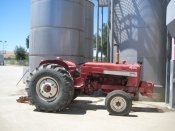 |
Energy +
|
 |
Greenhouse Gases
|
 Electricity prices are increasing by about 6% per year; fossil fuels are expensive and the security of their supply is questionable; and additional legislation and regulation of greenhouse gases Electricity prices are increasing by about 6% per year; fossil fuels are expensive and the security of their supply is questionable; and additional legislation and regulation of greenhouse gases  is expected to further increase energy costs. By reducing energy use per acre or ton of grapes or per gallon or case of wine, your business saves money and reduces its greenhouse gas footprint – a “win-win” for increasing sustainability. Use the calculator to quantify and track energy efficiency and greenhouse gas emissions for your vineyard or winery. Understandings from collecting data, generating results, and the educational information can be used to establish and communicate improvement plans and goals. is expected to further increase energy costs. By reducing energy use per acre or ton of grapes or per gallon or case of wine, your business saves money and reduces its greenhouse gas footprint – a “win-win” for increasing sustainability. Use the calculator to quantify and track energy efficiency and greenhouse gas emissions for your vineyard or winery. Understandings from collecting data, generating results, and the educational information can be used to establish and communicate improvement plans and goals.

|